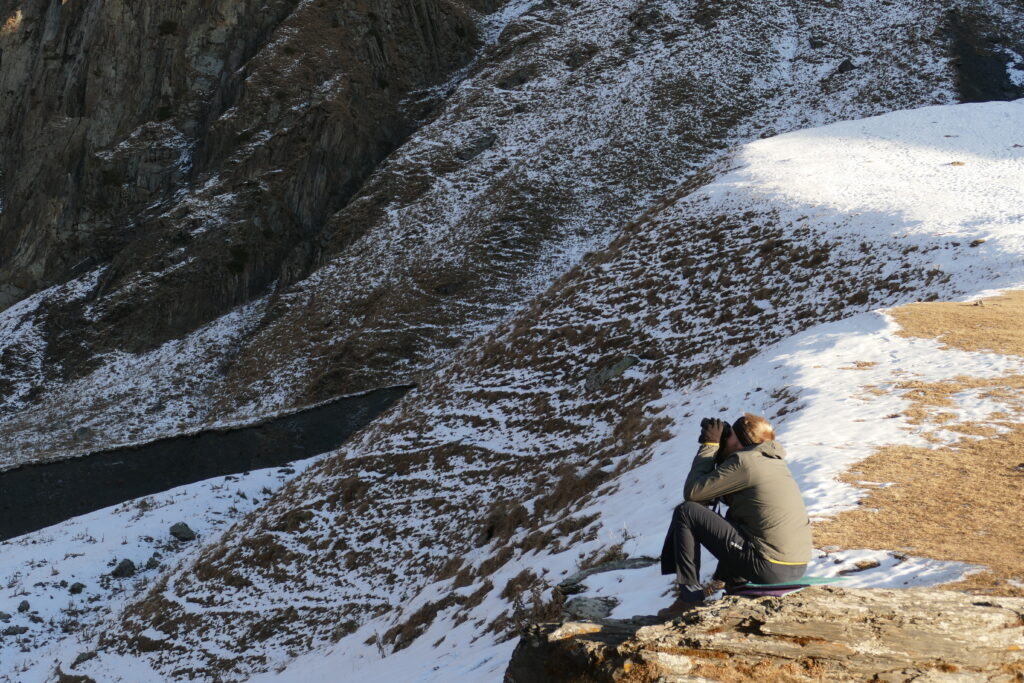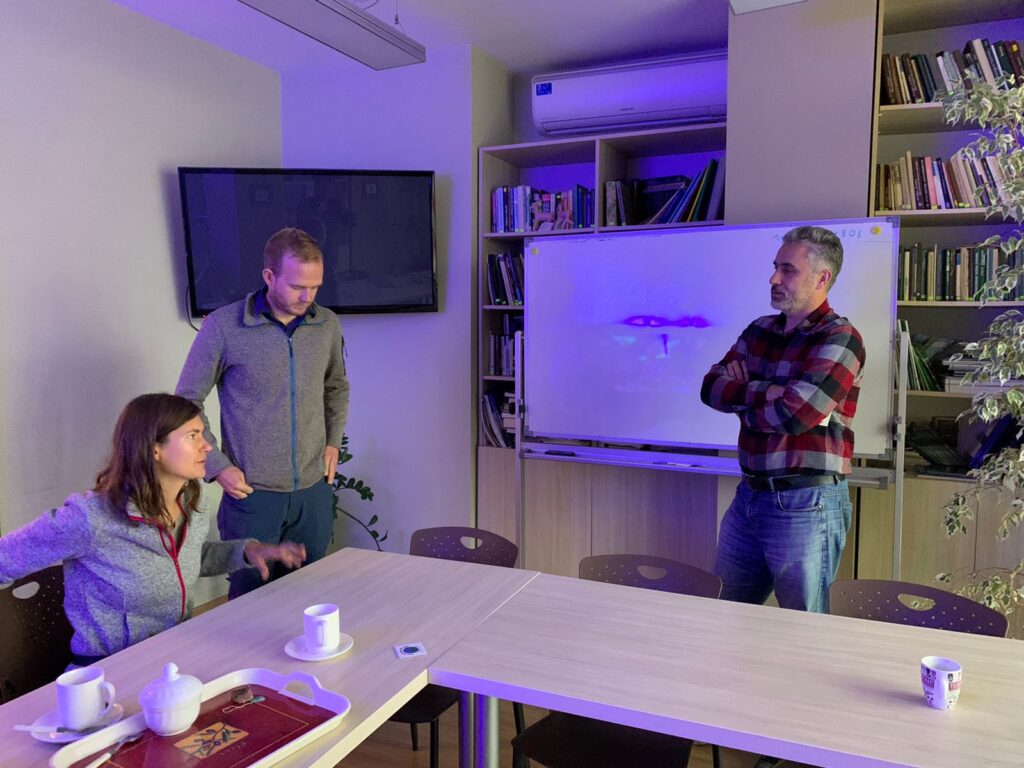In 1989 Soviet Georgia, sharing a common dream of safeguarding the biodiversity of Georgia, a group of individuals formed an alliance. For years they fostered this dream until in 1991, directly after the collapse of the Soviet Union, they could finally establish an NGO, with the name ‘Noah’s Ark Centre for the Recovery of Endangered Species’ (NACRES). Later renamed to ‘Centre for Biodiversity Conservation & Research’, throughout its 30 years of existence, NACRES has become a centrepiece in the conservation puzzle of Georgia. We had the chance to accompany the conservation team on their field work to monitor the East Caucasian turs in the mountainous Kazbegi National Park. We spent the days searching for Caucasian turs on the majestic slopes of the Kazbegi National Park, while the evenings were filled with talks about Georgian biodiversity, human-wildlife conflict, effectiveness of protected areas and capacity building of rangers.
East Caucasian turs – an indicator species for protected area effectiveness
The biodiversity of the Caucasus is under huge pressure. Much of the land has been transformed by humans and the most natural forest and wetland ecosystems have been fragmented. Agricultural lands, commercial forests and lands used for construction are taking over the landscape and depleting natural resources. In fact, by now only less than 12% of the country’s area can be considered pristine according to the Caucasus Nature Fund.
Therefore, protected areas have a crucial role in safeguarding biodiversity. But nothing in life is stagnating, even the nature within protected areas faces several pressures and threats. Over the years, NACRES has become the key player in assessing the linkages between the biodiversity of Georgian protected areas and the threats they face. Funded by the Caucasus Nature Fund and WWF, the experts of NACRES currently conduct the field analysis on the distribution and population dynamics of various key species in the protected areas of Georgia, identify potential pressures on the populations and prepare recommendations for the protected areas to improve their conditions. Under this umbrella, we joined the NACRES team on their winter monitoring work of the East Caucasian tur in Kazbegi.
The East Caucasian tur (Capra cylindricornis) is a mountain-dwelling caprine found only in the eastern half of the Greater Caucasus mountains, in Georgia, Azerbaijan, and Russia. Not only is the species categorized as ‘near-threatened’ in the IUCN’s Red List, it’s also a culturally important species in Georgia, mentioned in literature and poetry dating back centuries. Nevertheless, hunting − both legal and illegal − strongly affected all ungulate species of Georgia, and the East Caucasian tur was no exception. Partly because the red deer’s inclusion in the Red Data Book of Georgia in 1982 granted red deer more protection than the tur, the latter was more heavily hunted for decades.


Illegal hunting of East Caucasian turs was a common practice in the Caucasus (photos by the Caucasus Nature Fund).
Tur hunting even brought in foreign hunters, as tur horns were considered valuable trophies. Later in the 1990s, after the collapse of the Soviet Union, there was a huge political instability in the country which resulted in practically no control over hunting even in protected areas, meaning a sharp decline of not only all ungulate numbers but many bird species as well. Since this time however, the population has increased in Georgian protected areas. Nevertheless, there is still much unknown about population trends, distribution and seasonal habitat use of this species.
Monitoring with NACRES
As we arrive at Gudauri – our base for the next few days – we are immediately trained about how to identify the age and gender of these animals. The monitoring team consisted of nine people, five NACRES employees and four volunteers, including the two of us. National park rangers also help with the monitoring and in return learn from the experienced NACRES staff. The team works in groups of two observers, and we have to cover 14 observation points. The data gathered from these observation points is then extrapolated to the whole area of the national park. NACRES uses the double-observer method while monitoring. This means that the two observers of the group rotate in observing a specified area for 15 minutes each in four rounds. They work completely independently from each other and must not share their observations with each other to avoid any bias.




As we arrive to Kazbegi National Park, we meet the team, while we are in awe of the landscape. A griffon vulture greets us while soaring through the sky.
In December, such observations are also accompanied by creeping cold sometimes, and while we are not on duty, it’s definitely a good idea to run a couple loops to warm up the body. While we have both done wildlife monitoring before, our eyes have to get used to the colours and patterns of the mountains. As there has not been much snowfall this December in the Upper Caucasus, turs blend in well into the rocky, snow-free terrain. Therefore, on our first observation we fail to spot any individuals ourselves, though we are still able to observe the only solitary male that wanders through the observation range after Shota from NACRES pointed our attention to it.


However, the next day luck is on our side. We get up before sunrise and start our hike to a remote observation point.



We get there in time, and soon after we set everything up and start observing, we have a catch. A group of turs is moving upwards on the snowy terrain towards the ridge, and we start counting. As the group moves ahead, the counter moves up. Finally, we count over 105 individuals, including many young ones. What a success!






The winter monitoring in Kazbegi National Park is successfully completed, and with the results of the summer survey of 2022, NACRES will analyse the gathered information. Next year, they will continue tur monitoring in Lagodekhi National Park.
Filling in the gaps in training and capacity
The NACRES team are experts in wildlife monitoring and tracking. On the other hand, monitoring is also one of the tasks of national park rangers, who unfortunately often lack the time and training to conduct such monitoring according to scientific standards. Therefore, an important element of NACRES’s work is to involve and train a selected group of rangers to conduct tur monitoring using state of the art methodology.


Temur Popiashvili from NACRES explains to us that resources of rangers can be used more efficiently and instead of yearly monitoring using an inaccurate methodology, monitoring by professionals together with rangers should only be conducted once every 3 years to detect population trends.
The age-old battle: human-carnivore conflict
It can be considered a widely acknowledged wisdom that wildlife conservation and management is less about managing animal populations as it is about managing the people that interact with them. Therefore, for successful wildlife conservation, there must be a willingness to share the landscape with wildlife. Aside caucasian turs, wolves, lynx and bears are also indicator species NACRES monitors in protected areas, and throughout this work, they have encountered a strong public opposition against bears, wolves and wild boars. Thus, NACRES has also been active for decades in surveying people’s attitudes specifically towards large carnivores and introducing livestock protection measures.
Bejan Lortkipanidze, Conservation Programme Director at NACRES tells us about NACRES’s attempts to introduce a community-based insurance scheme as a financial mechanism to mitigate the costs of negative human–carnivore interactions. The NGO implemented a pilot, small-scale project in the Adjara mountains, where ten families participated and agreed to put up electric fences and take care of them. Applied hand-in-hand with livestock protection measures, like electric fences, livestock owners would pay an annual, small fee as an insurance for any livestock damage caused by large carnivores. Each case would be assessed by local rangers, and as Bejan explains, local councils would handle any profit that would remain at the end of the year and decide how it could best benefit the local community.



“In nature protection, the social side of our work is sometimes even more important than concrete conservation, such as monitoring species. To protect nature, we have to understand the motivation of people, and only then can we seek a solution that benefits both wildlife and people. And as an NGO, we must lobby these interests that fit both wildlife and humans towards decision-makers. Conservation people have to stand in-between.”
Bejan Lortkipanidze, Conservation Programme Director at NACRES
For those interested in learning more about the East Caucasian tur and its protectors in the Caucasus, we highly recommend the following documentary:


Pingback: Where does biodiversity protection end? - biking4biodiversity.org
Pingback: How Lagodekhi wants to end poaching - biking4biodiversity.org